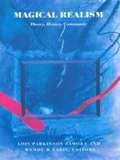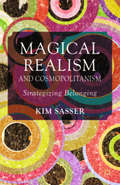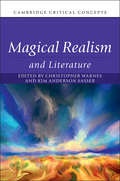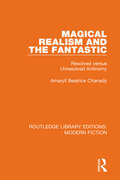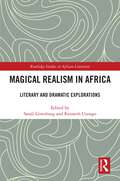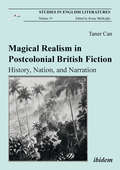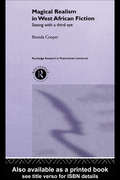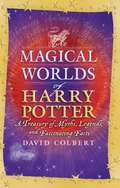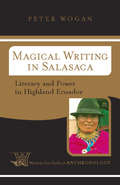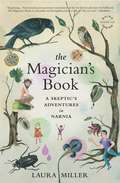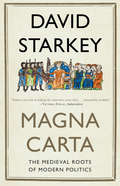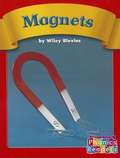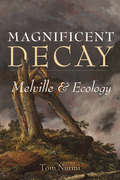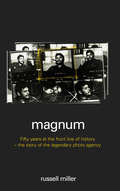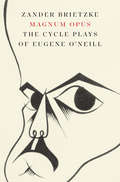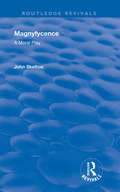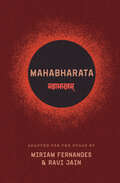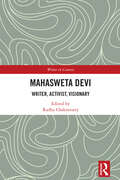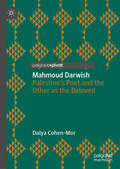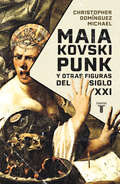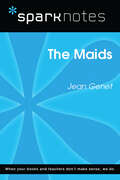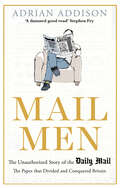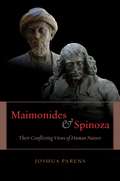- Table View
- List View
Magical Realism: Theory, History, Community
by Lois Parkinson Zamora Wendy B. FarisMagical realism is often regarded as a regional trend, restricted to the Latin American writers who popularized it as a literary form. In this critical anthology, the first of its kind, editors Lois Parkinson Zamora and Wendy B. Faris show magical realism to be an international movement with a wide-ranging history and a significant influence among the literatures of the world. In essays on texts by writers as diverse as Toni Morrison, Günter Grass, Salman Rushdie, Derek Walcott, Abe Kobo, Gabriel García Márquez, and many others, magical realism is examined as a worldwide phenomenon.Presenting the first English translation of Franz Roh's 1925 essay in which the term magical realism was coined, as well as Alejo Carpentier's classic 1949 essay that introduced the concept of lo real maravilloso to the Americas, this anthology begins by tracing the foundations of magical realism from its origins in the art world to its current literary contexts. It offers a broad range of critical perspectives and theoretical approaches to this movement, as well as intensive analyses of various cultural traditions and individual texts from Eastern Europe, Asia, North America, Africa, the Caribbean, and Australia, in addition to those from Latin America. In situating magical realism within the expanse of literary and cultural history, this collection describes a mode of writing that has been a catalyst in the development of new regional literatures and a revitalizing force for more established narrative traditions--writing particularly alive in postcolonial contexts and a major component of postmodernist fiction.
Magical Realism and Cosmopolitanism
by Kim Anderson SasserMagical Realism and Cosmopolitanism details a variety of functionalities of the mode of magical realism, focusing on its capacity to construct sociological representations of belonging. This usage is traced closely in the novels of Ben Okri, Salman Rushdie, Cristina Garc#65533;a, and Helen Oyeyemi.
Magical Realism and Literature (Cambridge Critical Concepts)
by Christopher Warnes Kim Anderson SasserMagical realism can lay claim to being one of most recognizable genres of prose writing. It mingles the probable and improbable, the real and the fantastic, and it provided the late-twentieth century novel with an infusion of creative energy in Latin America, Africa, Asia, and beyond. Writers such as Alejo Carpentier, Gabriel García Márquez, Isabel Allende, Salman Rushdie, Ben Okri, and many others harnessed the resources of narrative realism to the representation of folklore, belief, and fantasy. This book sheds new light on magical realism, exploring in detail its global origins and development. It offers new perspectives of the history of the ideas behind this literary tradition, including magic, realism, otherness, primitivism, ethnography, indigeneity, and space and time.
Magical Realism and the Fantastic: Resolved versus Unresolved Antinomy (Routledge Library Editions: Modern Fiction #5)
by Amaryll Beatrice ChanadyEvery reader of literature interprets the literary text on the basis of information they have acquired from previous reading, and according to norms they have established, either consciously or not, with regard to a work of literature. In this study, originally published in 1985, the author clarifies the concepts of magical realism and the fantastic, and establishes a series of guidelines that will allow us to distinguish between the two similar yet independent modes. The reader will thus be able to identify the implicit framework upon which the author of the fantastic and of magical realism bases their text.
Magical Realism in Africa: Literary and Dramatic Explorations (Routledge Studies in African Literature)
by Sarali Gintsburg Kenneth UsongoMagical realism has deep roots across many African languages and regions. This book explores African magical realism from a transregional and inclusive approach, drawing on contributions from different literary genres across the continent.The chapters in this book constitute a sustained and insightful reflection on the salient components of this literary genre as well as evaluating its connections to themes of conflict, violence, women’s rights, trauma, oppression, culture, governance, and connecting to the African self. As well as theorizing magical realism, this book engages with African expressive performance across various formats, novels, plays, and films. This book investigates African magical realism from its origins up to the present day, where local oral traditions link indigenous cosmogonic stories with Western literature, as well as with the specific narrative traditions of Arabo‑Islamic literature. The rich analysis draws on works from across the continent, including Egypt, Sudan, Mauritania, Cameroon, Kenya, Tanzania, Angola, and Mozambique.This book is a timely contribution to debates within African literature, cultural anthropology, ethnography, and folklore.
Magical Realism in Postcolonial British Fiction: History, Nation, and Narration (Studies in English Literatures #19)
by Taner CanThis study delineates the cultural work of magical realism as a dominant mode in postcolonial British fiction through a detailed analysis of Salman Rushdie's Midnight's Children (1981), Shashi Tharoor's The Great Indian Novel (1989), Ben Okri's The Famished Road (1991), and Syl Cheney-Coker's The Last Harmattan of Alusine Dunbar (1990). It first traces the development of magical realism from its origins in European painting to its appropriation into literature by European and Latin American writers. It then explores contested definitions of magical realism and the critical questions surrounding them and analyzes the relationship between the paradigmatic turn in postcolonial literatures and the concomitant rise of magical realism in Third World countries.
Magical Realism in West African Fiction: Seeing With A Third Eye (Routledge Research in Postcolonial Literatures)
by Brenda CooperThis study contextualizes magical realism within current debates and theories of postcoloniality and examines the fiction of three of its West African pioneers: Syl Cheney-Coker of Sierra Leone, Ben Okri of Nigeria and Kojo Laing of Ghana. Brenda Cooper explores the distinct elements of the genre in a West African context, and in relation to: * a range of global expressions of magical realism, from the work of Gabriel Garcia Marquez to that of Salman Rushdie * wider contemporary trends in African writing, with particular attention to how the realism of authors such as Chinua Achebe and Wole Soyinka has been connected with nationalist agendas. This is a fascinating and important work for all those working on African literature, magical realism, or postcoloniality.
The Magical Worlds of Harry Potter: A Treasury of Myths, Legends, and Fascinating Facts
by David ColbertHave Witches always flown on broomsticks? Where does magic come from? How did J. K. Rowling pick those weird names? Rowling fills Harry Potter's world with real history and famous legends from around the world. This book tells all about them. Discover the astonishing origins behind your favorite characters, scenes, beasts, and everything else too. From Alchemists to Unicorns; Basilisks to Veela, it's all here in this handy guide. Includes notations on Stone through Goblet as well as the HP textbooks.
Magical Writing in Salasaca: Literacy and Power in Highland Ecuador
by Peter WoganExplores the connections between beliefs about writing and power in an indigenous village in highland Ecuador.
The Magician's Book: A Skeptic's Adventures in Narnia
by Laura MillerTHE MAGICIAN'S BOOK is the story of one reader's long, tumultuous relationship with C.S. Lewis' The Chronicles of Narnia. Enchanted by its fantastic world as a child, prominent critic Laura Miller returns to the series as an adult to uncover the source of these small books' mysterious power by looking at their creator, Clive Staples Lewis. What she discovers is not the familiar, idealized image of the author, but a more interesting and ambiguous truth: Lewis's tragic and troubled childhood, his unconventional love life, and his intense but ultimately doomed friendship with J.R.R. Tolkien. Finally reclaiming Narnia "for the rest of us," Miller casts the Chronicles as a profoundly literary creation, and the portal to a life-long adventure in books, art, and the imagination.
Magistracy and the Historiography of the Roman Republic
by Ayelet Haimson LushkovThe study of Roman republican magistracy has traditionally been the preserve of historians posing constitutional and prosopographical questions. As a result, one fundamental aspect of our most detailed contemporary and near-contemporary sources about magistracy has remained largely neglected: their literariness. This book takes a new approach to the representation of magistrates and shows how the rhetorical and formal features of prose texts - principally Livy's history but also works by Cicero and Sallust - shape our understanding of magistracy. Applying to the texts an expanded concept of exemplarity, Haimson Lushkov shows how a rich body of anecdotes concerning the behaviour and speech of magistrates reflects on the values and tensions that defined the republic. A variety of contexts - familial, military, and electoral, among others - flesh out the experience of being, becoming, and encountering a Roman magistrate, and the political and ethical problems highlighted and negotiated in such circumstances.
Magna Carta: The Medieval Roots Of Modern Politics
by David StarkeyIn this erudite, entertaining book, award-winning historian and television presenter David Starkey untangles historical and modern misconceptions about one of the founding documents of democracy. Along the way, he shows how the Magna Carta laid the foundation for the British constitution, influenced the American Revolution and the U.S. constitution, and continues to shape jurisprudential thinking about individual rights around the world today.In 1215, King John I of England faced a domestic crisis. He had just lost an expensive campaign to retake his ancestral lands in France, an unfortunate adventure that he had funded by heavily taxing the baronial lords of England. Sick of the unpopular king's heavy-handed rule, and unimpressed by the king's unsuccessful attempt to seize Normandy, the feudal barons united to make demands of their sovereign for certain protections. These demands, the "Articles of the Barons," were submitted to the king in rough draft after the rebels occupied three cities, most significantly London. A few years later, after being edited and amplified by the then-Archbishop of Canterbury, the Articles would come to be known as the Magna Carta. The self-interested barons couldn't have known it at the time, but those demands would one day become the bedrock of democratic political development around the globe--even though that influence was largely due to mythologizing by later scholars who warped the symbolism of the document to support their arguments in favor of the rights of all citizens.Although the Magna Carta itself made no requests on behalf of the peasantry, in its structure the outlines of modern democratic reform are plainly visible. Among other things, it demanded limits on the ability of the crown to levy taxes; protection of the rights of the church; the guarantee of swift justice; and a ban on unjust imprisonment. Those protections and guarantees were strictly intended for benefit of feudal barons, but the free citizens of today's democratic nations owe an enormous debt to this history-changing document.
Magnets
by Wiley BlevinsPhonics Readers is a recognized leader in helping you teach phonics and phonemic awareness, within the context of content-area reading. Content area focus: Magnets; Phonics Skills: final e, l-blends
Magnificent Decay: Melville and Ecology (Under the Sign of Nature)
by Tom NurmiWhat is Melville beyond the whale? Long celebrated for his stories of the sea, Melville was also fascinated by the interrelations between living species and planetary systems, a perspective informing his work in ways we now term "ecological." By reading Melville in the context of nineteenth-century science, Tom Nurmi contends that he may best be understood as a proto-ecologist who innovatively engages with the entanglement of human and nonhuman realms. Melville lived during a period in which the process of scientific specialization was well underway, while the integration of science and art was concurrently being addressed by American writers. Steeped in the work of Lyell, Darwin, and other scientific pioneers, he composed stories and verse that made the complexity of geological, botanical, and zoological networks visible to a broad spectrum of readers, ironically in the most "unscientific" forms of fiction and poetry. Set against the backdrop of Melville’s literary, philosophical, and scientific influences, Magnificent Decay focuses on four of his most neglected works— Mardi (1849), Pierre (1852), The Piazza Tales (1856), and John Marr (1888)—to demonstrate that, together, literature and science offer collective insights into the past, present, and future turbulence of the Anthropocene. Tracing the convergences of ecological and literary creativity, Melville’s lesser-read texts explore the complex interplay between inanimate matter, life, and human society across multiple scales and, in so doing, illustrate the value of literary art for representing ecological relationships.
Magnum: Fifty Years at the Front Line of History
by Russell MillerThis book is a biography of Magnum, told largely in the words of its photographers. It offers a unique perspective on half a century of world history from an extraordinary group of men and women who were front line witnesses at virtually every major event in the last fifty years. Wars, famines, natural disasters, social, political and environmental crises - Magnum photographers were there. They have been acute observers of the human condition, photographing the richest people in the world, the poorest, the least known and the most celebrated, from Marilyn Monroe to Che Guevara, JFK to Nelson Mandela, Picasso to Krushchev. This is a multi-layered story. At one level, it tells how a small group of photographrs - among them Robert Capa, Henri Cartier-Bresson and George Rodger - came together, established and nurtured a co-operative photographic agency that has survived against all the odds to become the most famous in the world. At a secondary level, it is the richly anecdotal story of the photographers themselves, their adventures around the world and their feelings about, and reactions to, their assignments.
Magnum Opus: The Cycle Plays of Eugene O'Neill
by Zander BrietzkeAn original and provocative analysis of Eugene O'Neill's unfinished cycle play project From 1935 to 1939, Eugene O&’Neill worked on a series of plays that would trace the history of an American family through several generations. He completed just two of the proposed eleven plays—A Touch of the Poet and More Stately Mansions—which Zander Brietzke argues represent the core of the entire cycle. Combining archival research, literary analysis, and theatrical imagination, Magnum Opus invites an audience to see this unusual and exciting epic as a historical drama of our time.
Magnyfycence: A Moral Play (Routledge Revivals)
by John SkeltonFirst published in 1906, this edition of Magnyfycence aimed to highlight the true significance of the play within both the canon of John Skelton’s work and English drama. Robert Lee Ramsay situates Magnyfycence as a morality play which functioned as a bridge between medieval miracle plays and the modern comedy. He demonstrates the text’s significance as the first example of a play by an English man of letters and our first example of a secular and literary rather than theological morality play. This edition features an extensive scholarly introduction exploring areas such as the staging, versification, sources and characterisation, followed by the Middle-English text itself along with glosses.
Mahabharata
by Ravi Jain Miriam FernandesA contemporary dramatic take on a 4,000-year-old Sanskrit epic that is foundational to Indian culture. Why Not Theatre’s large-scale, once-in-a-generation retelling of Mahabharata brings together a cast of performers entirely from the South Asian diaspora, blending cultures and art forms in a spectacular production at the Shaw Festival and the Barbican Theatre in London. Over two parts (Karma and Dharma) and a communal meal (Khana), this translation and adaptation of Mahabharata spans generations and takes audiences into the hearts and minds of some of the most complex and enduring characters ever created. With warring families and devious revenge plots, Mahabharata tells the story of an ancient feud with philosophical and spiritual questions that are no less urgent today. In times of division, how do we find wholeness? Are we destined to repeat the mistakes of our ancestors? And how can we build a new world when we have nearly destroyed this one? Contains the full text of the play along with materials opening up the behind-the-scenes world of the production, including interviews with the creators, background and context about the source material, production photographs, a Mahabharata family tree, and glossary."Ravi Jain and Miriam Fernandes’s contemporary take on the Mahabharata is one of the most beautiful emotional journeys I have had the privilege to witness. It is inspiring, mind broadening, and speaks to all the senses. It even brings you back to the origins of theatre itself, when people would gather in the quarries around a bonfire to tell stories. With their tasteful use of technology, dance, and opera, the 4,000-year-old Sanskrit poem comes to life and feels more universal than ever. A captivating theatre experience, from the first flame to the last pixel." – Robert Lepage"In their stunning rendition of the great Indian epic Mahabharata, Ravi Jain and Miriam Fernandes brilliantly reverse the whole concept of what Bertolt Brecht famously advised theatre directors: to make the familiar, unfamiliar. Jain and Fernandes have turned the unfamiliar into the familiar. The 4,000-year-old saga most Indians grew up with is made accessible to a contemporary audience the world over. No mean feat. ‘The play, true to its source, crosses all boundaries of culture, class, and geography. Its timeless storytelling and evocative stage design is transformed into a saga for the world, with its fundamental emotions of human nature – power, hate, jealousy, greed, and lust. To be gob-smacked by this innovation would be an understatement. Immerse yourself in this take on the Mahabharata and travel with it in time into the past, present, and future of humanity." – Deepa Mehta
Mahasweta Devi: Writer, Activist, Visionary (Writer in Context)
by Radha ChakravartyMahasweta Devi occupies a singular position in the history of modern Indian literature and world literature. This book engages with Devi’s works as a writer-activist who critically explored subaltern subjectivities, the limits of history and the harsh social realities of post-independence India. The volume showcases Devi’s oeuvre and versatility through samples of her writing – in translation from the original Bengali—including Jhansir Rani, Hajar Churashir Ma, and Bayen among others. It also looks at the use of language, symbolism, mythic elements and heteroglossia in Devi’s exploration of heterogeneous themes such as exploitation, violence, women’s subjectivities, depredation of the environment and failures of the nation state. The book analyses translations and adaptations of her work, debates surrounding her activism and politics and critical reception to give readers an overview of the writer’s life, influences, achievements and legacy. It highlights the multiple concerns in her writings and argues that the aesthetic aspects of Mahasweta Devi’s work form an essential part of her politics. Part of the ‘Writer in Context’ series, this book will be useful for scholars and researchers of Indian literature, Bengali literature, English literature, postcolonial studies, cultural studies, global south studies and translation studies.
Mahmoud Darwish: Palestine’s Poet and the Other as the Beloved
by Dalya Cohen-MorMahmoud Darwish: Palestine’s Poet and the Other as the Beloved focuses on Palestinian national poet Mahmoud Darwish (1941–2008), whose poetry has helped to shape Palestinian identity and foster Palestinian culture through many decades of the Israeli-Palestinian conflict. Dalya Cohen-Mor explores the poet’s romantic relationship with “Rita,” an Israeli Jewish woman whom he had met in Haifa in his early twenties and to whom he had dedicated a series of love poems and prose passages, among them the iconic poem “Rita and the Gun.” Interwoven with biographical details and diverse documentary materials, this exploration reveals a fascinating facet in the poet’s personality, his self-definition, and his attitude toward the Israeli other. Comprising a close reading of Darwish’s love poems, coupled with many examples of novels and short stories from both Arabic and Hebrew fiction that deal with Arab-Jewish love stories, this book delves into the complexity of Arab-Jewish relations and shows how romance can blossom across ethno-religious lines and how politics all too often destroys it.
Maiakovski punk y otras figuras del siglo XXI
by Christopher Domínguez MichaelUna revisión crítica a la obra de los escritores más representativos de lo que va del siglo XXI. A El XXI en el XXI (2011) y La sabiduría sin promesa. Vida y letras del siglo xx (2001 y 2009), se suma Maiakovski punk y otras figuras del siglo XXI, donde Christopher Domínguez Michael continúa su examen de la literatura moderna. Extendiéndose a la centuria en curso, en este libro tenemos sus ensayos y artículos que van desde la lamentación por las ruinas de Palmira hasta las consecuencias de la “intervención” en la obra de Borges, pasando por una radiografía posmoderna del ateísmo proclamado por Hitchens y Onfray, la criminal inverecundia de Handke, la reposición de Camus realizada por Kamel Daoud, el neogótico rockero de Mariana Enriquez, la lucrativa farsa del llamado Arte Contemporáneo, el retorno de los apocalípticos en pantuflas como Agamben y Cía., la literatura en estado de peste y pandemia, y siguiendo a Michiko Kakutani, leemos, asimismo, cómo la posverdad pasó del gramatólogo Derrida al presidente Trump y miramos a la Ucrania en guerra, el solar de Bábel y Bulgákov. Pese a darle prioridad a las obras impresas en estos casi veinticinco años de la nueva centuria, Maiakovski punk y otras figuras del siglo xxi también recoge comentarios sobre novelas, cuentos, ensayos y poemas de Benedetti, Piglia, Fumaroli, Parra, Christa Wolf, Oscar del Barco, Lowell, Zurita o Vila-Matas, mostrando una vez más cómo la erudición, el humor, la acritud y la intransigencia frente a modas e ideologías, han hecho de Domínguez Michael uno de los críticos literarios más polémicos y cosmopolitas de nuestra lengua. Los críticos nos dicen «“Pues no sigas leyendo por ahora a Domínguez Michael”, me decía mi mujer, viendo que me desvelaba, como cuando me ve leer a Bloom o a Steiner. No era igual. Mi reacción no era polémica o en contra. Lo que sentía es que algo muy profundo (de los latinoamericanos) se estaba dilucidando en lo que leía.» -Guillermo Sucre (1997) «Jamás he tenido la oportunidad de presenciar, reconocer, discutir en mi interior, oponerme a ella o estremecerme con la obra de un crítico absoluto. Este privilegio materializado en mi lengua y en América me ha acompañado durante años. Deriva de los libros de Domínguez Michael, que se convierten en el renacimiento del pensamiento literario.» -José Balza (2012)
The Maids (SparkNotes Literature Guide Series)
by SparkNotesThe Maids (SparkNotes Literature Guide) by Jean Genet Making the reading experience fun! Created by Harvard students for students everywhere, SparkNotes is a new breed of study guide: smarter, better, faster. Geared to what today's students need to know, SparkNotes provides: *Chapter-by-chapter analysis *Explanations of key themes, motifs, and symbols *A review quiz and essay topicsLively and accessible, these guides are perfect for late-night studying and writing papers
Mail Men: The Unauthorized Story of the Daily Mail
by Adrian AddisonDiscover the secret history of the paper that has shaped Britain and taken over the world. Perhaps because of the power and fear that the Daily Mail commands, this is the first book to provide an unauthorized account of the newspaper with more global readers than any other. With a gripping personality-led narrative, informed by sources near the top of the paper, Mail Men investigates the secret behind the Mail's extraordinary longevity and commercial success. But, it also examines the controversies that have beset the paper—from its owner's flirtation with fascism in the 1930s to its fractious relationship with liberals, celebrities and politicians today. Asking why the Mail attracts such anger around the world, Addison explores how insiders view the furore the paper creates both in its print and online incarnation. He also uses his numerous contacts to ask how the paper has stayed relevant for over a century. How has MailOnline built such a huge global audience by focussing on celebrity gossip, in apparent tension with the sometimes puritanical values of its sister print edition? Gripping and revealing, this book gives a previously unseen insight into the colorful cast of senior MailMen (yes, nearly all men) who have molded the paper through the decades—from Alfred C. Harmsworth, the Mail's founder and first owner, a frenetic genius who invented the popular press as we know it, to Martin Clarke, the fearsome Scot who runs MailOnline, the most popular newspaper website in the world.
Maimonides and Spinoza: Their Conflicting Views of Human Nature
by Joshua ParensUntil the last century, it was generally agreed that Maimonides was a great defender of Judaism, and Spinoza--as an Enlightenment advocate for secularization--among its key opponents. However, a new scholarly consensus has recently emerged that the teachings of the two philosophers were in fact much closer than was previously thought. In his perceptive new book, Joshua Parens sets out to challenge the now predominant view of Maimonides as a protomodern forerunner to Spinoza--and to show that a chief reason to read Maimonides is in fact to gain distance from our progressively secularized worldview. Turning the focus from Spinoza's oft-analyzed Theologico-Political Treatise, this book has at its heart a nuanced analysis of his theory of human nature in the Ethics. Viewing this work in contrast to Maimonides's Guide of the Perplexed, it makes clear that Spinoza can no longer be thought of as the founder of modern Jewish identity, nor should Maimonides be thought of as having paved the way for a modern secular worldview. Maimonides and Spinoza dramatically revises our understanding of both philosophers.
